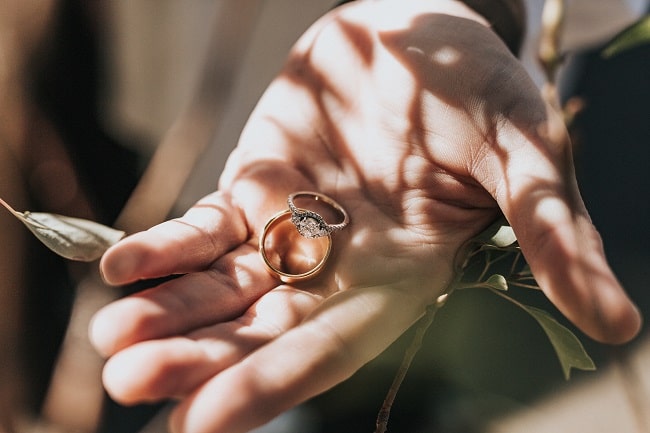1
HOME > Tips & Advice >
CHOOSING THE RIGHT PRECIOUS METAL FOR AN ENGAGEMENT RING
SHOULD YOU GO GOLD OR PLATINUM?
Written by Menswear Style in Tips & Advice on the 5th March 2019

Most of today’s fine jewellery is created using either gold or platinum. However, they both have differences, so what are they and which metal should you pick when purchasing an engagement ring? Most people will be familiar with the precious metal gold, which has been the ‘standard’ choice for thousands of years due to its value and beauty. The alternative is platinum which is actually even rarer and more valuable and therefore has become the preferred choice in recent years.
What is the difference in weight between gold and platinum rings?
First let’s cover the weight of these metals, as there is a clear difference in the density of platinum and gold. It is well known that gold is a heavy metal however platinum has an even greater density, so much so that you will find a platinum engagement ring to be almost 50% heavier than an 18ct white gold ring. Overall this won’t have a huge impact on the wearer of the ring, but it is still noticeable and something to consider.

What is the difference in colour?
The weight difference may have been a surprise but the clear difference between gold and platinum is the colour of these metals. As is commonly known, gold in its natural state, is a yellow colour. To create the other common colours like rose gold and white gold it has to be mixed with other metals to create an alloy and we will discuss this later on. Platinum however is a naturally light grey colour. The biggest decision faced when buying an engagement ring is whether to choose platinum or white gold. Let’s tackle this head on with some useful facts about these metals. Platinum in its natural form is a light grey colour, however once it’s polished the metal becomes particularly reflective of light and will appear bright white. On the other hand, even once polished, white gold is a slightly off white and retains a subtle hint of yellow. This is often avoided if the white gold is rhodium plated (which most white gold is), in this form you will find it even whiter than that of platinum. However, in recent years the popularity for rose gold rings has seen a large increase.

What are alloys, hallmarks and carats?
The first thing to note is that both platinum and gold have to be turned into alloys (mixed with other metals) so that they become stronger and more hardwearing. If they weren’t, their pure metal form is very soft and would not be durable enough for jewellery. During the alloy process the different colours of gold (rose, yellow and white) are created. To create the rose gold pink hue, it is mixed with copper only, for yellow gold it is a mixture of copper and silver, and to create white gold a combination of gold, silver and palladium is used. Gold in its purest form is referred to as fine gold or 24ct gold (24 carat). However here in the UK when gold is used in rings and other high-end jewellery it will be 18ct, this is due to it being alloyed with other metals and becoming less pure. 18ct means 18 out of 24 parts and therefore a 75% purity. 18ct gold will be hallmarked in the UK as 750 which is another way to describe the purity; in other words 750 parts gold from 1000. The US is slightly different and 14ct is the preferred choice which is just over 58% purity. Platinum is alloyed to a different percentage - in the UK this is usually 95% - which means in the UK the hallmark used is 950 which signifies 950 parts platinum out of 1000.

What is the malleability and strength?
When used to create engagement rings the strength, and more specifically malleability, is an important consideration. In general gold is more malleable than platinum. This means gold is usually more suitable when setting soft gemstones, such as emeralds, as less force is required which could potentially damage the gemstone. If you are only looking at diamond engagement rings, then platinum or gold metal is suitable.
Does gold or platinum last longer?
Not only is the malleability important, but also the general strength of the metal over time which will be affected due to wear and tear. For example, despite the tensile strength of platinum it can also be marked easily, it is common for a platinum ring to show up many small scratches on the surface. Due to the day-in-day-out wearing of engagement and wedding rings they will be subjected to a variety of stresses and knocks, especially where the ring is regularly contacted by other surfaces such as the underside. Overtime this contact causes platinum to become greyer in colour losing its polished shine. It is advisable to have platinum rings polished after a few years. With gold rings that have been plated with rhodium the wearing that occurs will damage the ring in a different way. As the plating wears off the yellower colour of the white gold will start to show through, therefore after a few years the ring will need to be plated again and polished.

What metal has less impact on the environment and is more sustainable?
As much as 20 tons of waste can be produced when mining enough gold for a single engagement ring. Any metals being mined, whether it’s gold or platinum will have an affect on the environment. However there are more ethical ways to source this metal e.g. for a white gold engagement ring you should consider a brand that works with Fairtrade gold, such as Ingle & Rhode. Fairtrade gold comes with assurances that provide the people working in these mines a fair price for the gold they produce, and it also ensures measures are in place for health and safety and stops child labour. Although there is no Fairtrade alternative for platinum at the moment, you can work with a brand who will only source recycled platinum for their rings. Therefore, reducing the impact that the mining activity has. Ingle & Rhode have some great resources for finding out more about the ethical sourcing of metals, including recycled platinum and Fairtrade gold.
Trending
2
3
4
5
6
7
8
9
10









